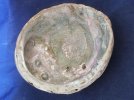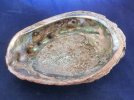I have worked a lot of abalone shell. It can be really frustrating to get a good scale out of, and a matching pair can be elusive. Scales over 2.5"X.75" are hard to make.
Work it wet, cut and sand with slow speed, wear a respirator. Whenever possible, work outside.
Like most everyone else, I had been taught that the dust was deadly toxic. I have learned that it is noxious ( smells horrible, and makes you nauseous), but not toxic - basically calcium carbonate. The fineness and sharpness of the dust is the danger. Wash and vacuum everything well after working the shell. If you don't have a diamond wire saw, or a diamond tile saw ( wet saw) and slow speed wet sanding equipment, making abalone scales will be much more difficult. I have heard that some folks use a hack saw with an abrasive blade. A garden hose or bucket of water is a must.
Make the first cut from the outside along the knuckles line (row of bumps). Make parallel cuts across the shell from there. Grind from the outside inward first, and then from the inside outward. The shell is regularly riddled with holes. Some holes can be filled with CA, and others can be left for "character". Sand to 400-600 grit buy hand and polish by buffing with white rouge.




